CBS News
University protests over Israel-Hamas war lead to more clashes between police and demonstrators on campuses nationwide

Ohio State University joined the growing list of college protests against Israel’s war against Hamas in Gaza. Clashes between protesters and police on the campus overnight resulted in over a dozen arrests.
Those who refused to leave after warnings were arrested and charged with criminal trespass, said university spokesperson Benjamin Johnson, citing rules barring overnight events.
Cole Behrens/Columbus Dispatch/USA Today Network via Reuters
As the death toll mounts in the war in Gaza and the humanitarian crisis worsens, protesters at universities across the country are demanding schools cut financial ties to Israel and divest from companies they say are enabling the conflict. Some Jewish students say the protests have veered into antisemitism and made them afraid to set foot on campus, partly prompting the calls for police intervention.
Saar Noy Zylberman, a Jewish student at Columbia University in New York City who grew up in Israel, told CBS News correspondent Nancy Chen on Thursday that many students knew people at the music festival that was targeted in Hamas’ deadly terror attack last year.
“And adding to that the situation where people scream hateful speech who have harassed and attacked both verbally and physically people, it’s just making it impossible to be here,” Zylberman told Chen.
New York City Mayor Eric Adams said police officers were hit with bottles and other objects at some of this week’s protests. He blamed outside agitators for joining in with genuine protesters. Officials at Emory University in Atlanta and the University of Texas at Austin have said that not everyone at their schools’ protests were students and that outside groups initiated or joined the demonstrations.
At Emory, local and state police swept in to dismantle an encampment Thursday. Some officers carried semiautomatic weapons, and video shows officers appearing to use a stun gun on one protester they had pinned to the ground. The university said late Thursday that objects were thrown at officers and they deployed “chemical irritants” as a crowd control measure.
Jail records showed 22 people arrested by Emory police were charged with disorderly conduct. Emory said it had been notified that 28 people were arrested, including 20 members of the university community, and some were released.
Elijah Nouvelage/AFP via Getty Images
In Texas, the UT Austin campus was much calmer Thursday after 57 people were jailed and charged with criminal trespass a day earlier, when state troopers in riot gear and on horseback bulldozed into protesters.
Both police and protesters have at times crossed a line, said Greg Lukianoff, the president of the Foundation for Individual Rights and Expression.
“You don’t have a generalized First Amendment right to, you know, turn the public area of a campus into a camping ground,” Lukianoff told CBS News. “But definitely we’ve seen at places like Emory and places like UT Austin, police taking things much, much too far.”
At UT Austin, officials have since pulled back barricades and allowed demonstrators onto the main square beneath the school’s iconic clock tower. The Travis County Attorney’s Office, which prosecutes misdemeanor crimes, dropped 46 cases stemming from Wednesday’s protests after finding deficiencies in the probable cause affidavits, a spokesperson said in a statement.
Reuters/Nuri Vallbona
Most detained demonstrators have not been charged with violent offenses, but there have been several instances of threatening and abusive behavior.
After a tent encampment popped up Thursday at Indiana University Bloomington, police with shields and batons shoved into protesters and arrested 33. Hours later at the University of Connecticut, police tore down tents and arrested one person.
The clock is ticking as May commencement ceremonies near, putting added pressure on schools to clear demonstrations. At Columbia, protesters defiantly erected a tent encampment where many are set to graduate in front of families in just a few weeks.
Columbia officials said that negotiations were showing progress as the school’s self-imposed early Friday deadline to reach an agreement on dismantling the encampment came and went. Nevertheless, two police buses were parked nearby and there was a noticeable presence of private security and police at entrances to the campus.
“We have our demands; they have theirs,” said Ben Chang, a spokesperson for Columbia University, adding that if the talks fail the university will have to consider other options.
Just past midnight, a group of some three dozen pro-Palestinian protesters handed out signs and started chanting outside of the locked Columbia University gates. They then marched away as at least 40 police officers assembled nearby.
On Friday morning, hundreds of counterprotesters gathered on the streets outside Columbia, many holding Israeli flags and chanting for the hostages being held by Hamas and other militants to be released.
Adam Gray/Getty Images
California State Polytechnic University, Humboldt, has been negotiating with students who have been barricaded inside a campus building since Monday, rebuffing an attempt by the police to clear them out. Faculty members met with protesters Thursday to try to negotiate a solution as the campus remains shut down at least through the weekend.
A dean at the school, Jeff Crane, suggested during the meeting that the university form a committee that would include students to do a deep dive into the school’s investments. Crane also suggested faculty and students continue meeting every 24 hours to keep an open line of communication. The sides have yet to announce an agreement.
The school’s senate of faculty and staff demanded the university’s president resign in a vote of no confidence Thursday, citing the decision to call police in to remove some barricaded students Monday.
On the other end of the state, the University of Southern California canceled the school’s May 10 graduation ceremony. The announcement was made a day after more than 90 protesters were arrested on campus. The university said it will still host dozens of commencement events, including all the traditional individual school commencement ceremonies.
Tensions were already high after USC canceled a planned commencement speech by the school’s pro-Palestinian valedictorian, citing safety concerns.
At the City College of New York on Thursday, hundreds of students who were gathered on the lawn beneath the Harlem campus’ famed gothic buildings erupted in cheers after a small contingent of police officers retreated from the scene. In one corner of the quad, a “security training” was held among students.
Elsewhere in the city, around a dozen protesters spent the night in tents and sleeping bags inside a building at the Fashion Institute of Technology. The institute’s museum, which is located in the building where the demonstrators set up camp, was closed Friday.
Protesters also stayed overnight at the encampment at George Washington University, according to local news stations. In a statement after the Thursday evening deadline to disperse, the university in Washington said the encampment violated university policies and that the administration and police were figuring out how to address the situation.
At Emerson College in Boston, 108 people were arrested at an encampment by early Thursday. Video shows police first warning students in an alleyway to leave. Students linked arms to resist officers, who moved forcefully through the crowd and threw some protesters to the ground.
“As the night progressed, it got tenser and tenser. There were just more cops on all sides. It felt like we were being slowly pushed in and crushed,” said Ocean Muir, a sophomore.
Muir said police lifted her by her arms and legs and carried her away. Along with other students, Muir was charged Thursday with trespassing and disorderly conduct.
Boston police said four officers suffered injuries that were not life-threatening during the confrontation.
Since the Israel-Hamas war began, the U.S. Education Department has launched civil rights investigations into dozens of universities and schools in response to complaints of antisemitism or Islamophobia. Among those under investigation are many colleges facing protests, including Harvard and Columbia.
CBS News
“Sandwiches of History”: Resurrecting sandwich recipes that time forgot

Barry Enderwick is eating his way through history, one sandwich at a time. Every day from his home in San Jose, California, Enderwick posts a cooking video from a recipe that time forgot. From the 1905 British book “Salads, Sandwiches and Savouries,” Enderwick prepared the New York Sandwich.
The recipe called for 24 oysters, minced and mixed with mayonnaise, seasoned with lemon juice and pepper, and spread over buttered day-old French bread.
Rescuing recipes from the dustbin of history doesn’t always lead to culinary success. Sampling his New York Sandwich, Enderwick decried it as “a textural wasteland. No, thank you.” Into the trash bin it went!
But Enderwick’s efforts have yielded his own cookbook, a collection of some of the strangest – and sometimes unexpectedly delicious – historical recipes you’ve never heard of.
Harvard Common Press
He even has a traveling stage show: “Sandwiches of History Live.”
From the condiments to the sliced bread, this former Netflix executive has become something of a sandwich celebrity. “You can put just about anything in-between two slices of bread,” he said. “And it’s portable! In general, a sandwich is pretty easy fare. And so, they just have universal appeal.”
Though the sandwich gets its name famously from the Fourth Earl of Sandwich, the earliest sandwich Enderwick has eaten dates from 200 B.C.E. China, a seared beef sandwich called Rou Jia Mo.
He declared it delicious. “Between the onions, and all those spices and the soy sauce … oh my God! Oh man, this is so good!”
While Elvis was famous for his peanut butter and banana concoction, Enderwick says there’s another celebrity who should be more famous for his sandwich: Gene Kelly, who he says had “the greatest man sandwich in the world, which was basically mashed potatoes on bread. And it was delicious.”
Whether it’s a peanut and sardine sandwich (from “Blondie’s Cook Book” from 1947), or the parmesian radish sandwich (from 1909’s “The Up-To-Date Sandwich Book”), Enderwick tries to get a taste of who we were – good or gross – one recipe at a time.
RECIPE: A sophisticated club sandwich
Blogger Barry Enderwick, of Sandwiches of History, offers “Sunday Morning” viewers a 1958 recipe for a club sandwich that, he says, shouldn’t work, but actually does, really well!
MORE: “Sunday Morning” 2024 “Food Issue” recipe index
Delicious menu suggestions from top chefs, cookbook authors, food writers, restaurateurs, and the editors of Food & Wine magazine.
For more info:
Story produced by Anthony Laudato. Editor: Chad Cardin.
CBS News
The cream of the crop in butter

Watch CBS News
Be the first to know
Get browser notifications for breaking news, live events, and exclusive reporting.
CBS News
Baking an ancient bread in Tennessee

Watch CBS News
Be the first to know
Get browser notifications for breaking news, live events, and exclusive reporting.












